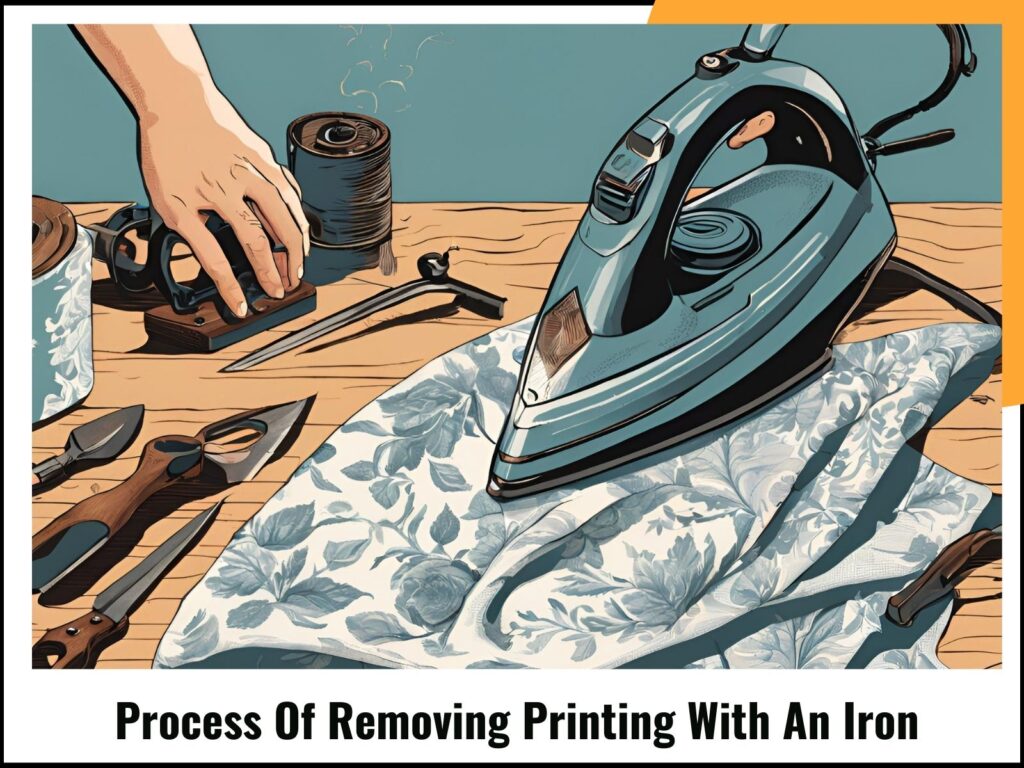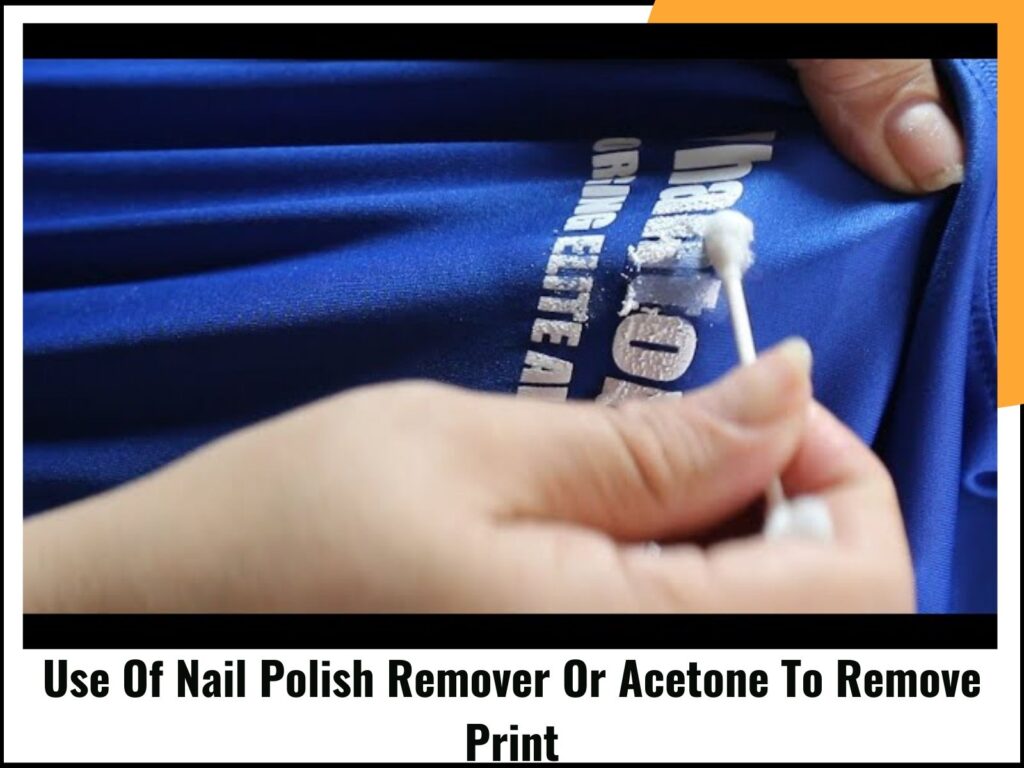Owning a T-shirt with the perfect fit, texture, and colors can bring so much joy, but when an unwanted print distracts from its appeal, it can be frustrating.
Fortunately, there are methods to apply for removing prints without compromising your shirt’s quality.
Whether you’re looking to keep your favorite T-shirt wearable or simply refresh its look, a little effort can make a big difference.
By using tools you likely already have, such as an iron, and following some special tips, you can effectively remove the print.
With patience and care, it’s possible to tackle even stubborn designs and transform your shirt into one you’ll love wearing again.
Table of Contents
ToggleProcess Of Removing Printing With An Iron

Using heat is one of the most effective methods to remove prints from a shirt, and an iron makes the process both easy and practical.
Start by placing your T-shirt on a flat surface and applying a steady amount of heat directly over the printed decoration.
Be sure to use a protective layer, like a thin cloth, to avoid damaging the shirt. In just a few simple steps, the print will begin to loosen, allowing you to gently peel it away.
This method works well whether you’re trying to remove prints at home or experimenting with other techniques like using acetone for more stubborn designs.
With proper care, you’ll find this process straightforward and satisfying.
Step-by-Step Guide To Remove Print on Shirt with an Iron:
Using a step-by-step guide, you can effectively remove printed designs from shirts with a simple method involving heat application.
Begin by laying your shirt on a flat surface, ensuring the fabric is smooth and ready for the process.
Place a thin cloth over the printed area to protect the fabric from direct heat, then apply the iron with consistent pressure.
As the heat penetrates, the design will loosen, allowing you to carefully peel it away without causing minimal damage to the shirt.
This method ensures your shirt remains in great condition while effectively addressing unwanted prints.
Step1: Set your iron to a low to suitable heat setting
When it comes to removing prints from your shirt, the first step is to set your iron to a low or suitable heat setting.
While a higher temperature is preferable for effective removal, it’s important not to automatically adjust your iron to the highest setting, as this can ruin both the fabric and the print.
Depending on the material types of your shirt and the recommendations provided by the manufacturer, you should adjust the temperature accordingly.
This will ensure you can safely and effectively remove the print without damaging your shirt or using any harsh chemicals like acetone.
Step2: Apply heat to the print area
To effectively remove print from your shirt, the next step involves applying heat to the print area.
One method is to position the iron on the back of the fabric, ensuring no direct contact between the iron and the prints.
This approach allows the heat to emit through the fabric, gradually melting the print from the front.
It’s crucial to let the iron stand firmly on the surface, while wrapping the fabric around its soleplate to secure it in place.
Alternatively, using a clean cloth to cover the print and then gently applying heat on top of it can be an effective method as well.
The heat application works its magic, safely removing the print without causing any damage to the fabric, provided the correct temperature and iron settings are used.
Step 3: Remove the melted print
After the print has melted, it becomes easier to remove. To do so, use a sharp knife or any pointy edge tool to carefully peel off the print.
If you placed the iron on the back of the fabric earlier, make sure to adjust the temperature accordingly.
Be cautious while removing the print, as the heat can cause burns. If the print remains tough to peel, reapply the heat and set the temperature slightly higher to soften it further.
It’s important to handle the fabric with care to avoid damage, especially if it’s delicate. Always test an inconspicuous area first to ensure the fabric isn’t overly sensitive.
Once the print is gone, there may still be some residual ink or marks. Don’t worry; you can easily clean the fabric by washing it to remove any remaining residue.
Keep in mind that this method may not work if the ink has been set too deeply into the fabric. In such cases, exploring other options for print removal might be necessary.
Use Of Nail Polish Remover Or Acetone To Remove Print

If you’re looking to remove prints from fabric quickly and effectively, nail polish remover with acetone is a highly recommended solution.
This method works well for cracking or old screen prints, as the acetone, a powerful solvent (dimethyl ketone), can effortlessly dissolve ink designs without damaging the fabric.
When using this method, be sure to apply the remover carefully to avoid fabric damage. Acetone effectively dissolves the print, leaving you with a clean surface.
This print removal method is not only easy but also quick, making it a great option if you’re looking to restore your t-shirt or fabric to its original condition without using an iron.
Just remember to follow proper fabric protection steps and test on an inconspicuous area first to ensure no unwanted side effects occur.
The Process:
To remove the print from your T-shirt, start by turning it inside out, which helps protect the front from damage.
Apply acetone generously to the backside of the fabric, ensuring that it soaks into the entire printed area.
Give the acetone a few moments to dissolve the print, and gently stretch the fabric to make the process work faster.
Once the print starts dissolving, flip the T-shirt back to the front and carefully begin peeling and scraping off the print.
If the print doesn’t come off completely, repeat the process, applying more acetone and soaking the fabric until the print residue is entirely removed.
Always be mindful of fabric handling and ensure that the acetone doesn’t damage the material while dissolving the print.
Useful Tips
- When removing print from a shirt, it’s crucial to ensure you’re in a well-ventilated space or even outdoors due to the harmful chemicals acetone may release.
- A facemask can help reduce the solvent smell, making the process more comfortable.
- Keep in mind that acetone can discolor or damage delicate fabrics, so testing on a small, inconspicuous area first is essential to make sure the fabric won’t be harmed.
- Only proceed to apply acetone to the printed area once you’re confident that the fabric won’t react negatively.
- Proper ventilation is key to safely handling acetone and ensuring fabric protection during the print removal process.
Solvents
When it comes to removing prints, you’re not limited to just acetone. There are a variety of alternative products and solvents that can also effectively dissolve ink and remove prints.
The procedure for these solvents is similar to acetone: simply apply them to the printed area of the fabric, allowing the solvent to soak in and break down the ink.
Whether you’re using acetone or other solvent options, it’s essential to ensure fabric protection during the process, as certain solvents might affect the fabric material or cause discoloration.
Each solvent has its own print removal method, so it’s crucial to test it on a small area of the fabric before proceeding.
By following the right print dissolving technique, you’ll be able to effectively remove prints without damaging the fabric or leaving ink residue behind.
Instructions:
To begin, gather the necessary products, such as rubbing alcohol or an adhesive remover, which can be easily found at a convenience store or around the house.
Before using the solvent on the print, test it on a smaller area of the fabric to ensure it is safe to use and won’t damage the material.
Once the solvent is confirmed to be safe, dampen your T-shirt with it, focusing on the printed area.
The solvent will begin to dissolve the print, and you can start peeling or rubbing it off.
If the print doesn’t come off completely with the first try, repeat the process, applying more solvent and checking the progress until the print is fully removed.
Some prints may need multiple applications for a complete removal.
Key Tips:
After you’ve worked on removing the print, it’s essential to wash the shirt thoroughly to eliminate any solvent residue left behind.
Be sure to wear a glove during the process to avoid direct contact with the solvents, as they can irritate the skin.
By following this method, you’ll ensure both the removal of the print and the safe handling of solvents, leaving your shirt clean and residue-free.
Use Of Plastisol Remover

If traditional methods haven’t worked and you’re still struggling to remove the print from your shirt, you might want to resort to a specialized solution like plastisol remover.
This ink type is commonly used in screen printing and can be particularly tough to get rid of without the right treatment.
Using plastisol remover is one of the most effective ways to completely remove screen print.
To do this, follow a step-by-step guide to apply the remover, ensuring it dissolves the ink and leaves your fabric clean without causing damage.
This method is highly recommended for stubborn prints and is a popular choice for achieving successful results.
Instructions
Start by applying the plastisol remover as per the instructions on the product label.
Different brands may have distinct methods for application, so it’s crucial to follow the guidelines carefully.
Once applied, allow the remover to sit for the recommended time, usually around 30 minutes, as this gives it the opportunity to penetrate and soften the ink.
After the ink has softened, gently wipe away the screen print with a brush or soft cloth, ensuring all residue is removed.
If necessary, you can also wash the shirt afterward to eliminate any remaining print or plastisol residue.
Key Tips:
To effectively remove a screen print from your shirt, be sure to follow the safety precautions outlined by the product instructions.
Always work in a well-ventilated area and wear gloves to avoid any potential skin irritation from the chemicals.
This method works especially well with plastisol-based inks, which are commonly used in screen printing.
Keep in mind that the process can be more successful if you give it time to work as directed, and remember that the product’s instructions should always be followed to ensure the most effective results.
Use Of Fluid To Remove Spots

For effective removal of screen print ink, spot removal fluid serves as a valuable option, especially among screen printers who regularly deal with stray ink spots.
This method ensures you can completely remove the screen print without causing damage to the material.
However, it’s essential to recognize that using this approach requires special equipment and products, which can be costly for one-time usage.
If you are working with bulk prints, the use of spot removal fluid is highly recommended.
It’s a great solution for erasing designs, and spot-cleaning guns with air compressors or toy water guns can make the process even more precise.
Just remember to spray carefully on the design only, avoiding the plain fabric to prevent damage.
Like plastisol removal, finishing the process by washing your product ensures that all chemicals are completely removed.
Instructions
To effectively remove a screen print from a shirt, start by placing a soft cloth on the backside of the fabric to protect it from the spray.
Use an air compressor or a compressed gun to apply spot removal fluid directly onto the printed area.
The fluid breaks down the ink instantly, making it easier to clean the surface.
Work the method thoroughly by spraying across the entire design until the print resolves and lifts off completely.
Gently clean any excess fluid with another soft cloth to ensure the material remains intact.
After removing the prints, wash the screen printed shirt to rinse away any remaining residues, leaving the fabric fresh and free from unwanted designs.
Key Tips
When dealing with a printed shirt, it’s essential to start by checking the fabric care label to ensure the material is compatible with the chosen spot removal fluid.
Before beginning the removal process, prioritize safety by wearing a mask and gloves to handle the chemicals.
Spray the fluid carefully over the printed area, making sure to apply it evenly without over-saturating the fabric.
Promptly wash the shirt once the print has been removed to eliminate any lingering residue or chemical traces.
This effective method ensures thorough cleaning while preserving the material and avoiding damage.
By focusing on proper application and safe use, the screen printing can be removed successfully, leaving the shirt ready for further use.
Conclusion
Removing screen prints from a shirt is an effective way to extend the life of your favorite fabric while reducing fashion waste.
By choosing a practical method tailored to the material and ensuring proper care during the process, you can promote sustainable practices and breathe new life into old designs.
Recycling clothes by removing unwanted prints not only refreshes your wardrobe but also supports a more eco-friendly approach to clothing care.
FAQs
Q1: Can I remove prints from any type of fabric?
Not all fabrics are suitable for print removal. Delicate or synthetic materials may react differently to chemicals or methods, so always check the fabric care label.
Q2: What is the most effective method for removing screen prints?
Using a spot removal fluid with a compressed spray gun is often effective, as it breaks down the print quickly without damaging the fabric.
Q3: Is it safe to use chemicals for removing prints?
Yes, but safety precautions such as wearing gloves, a mask, and working in a well-ventilated area are essential to avoid exposure to fumes or skin irritation.
Q4: Will removing the print damage my shirt?
If done carefully and with the right method for the material, damage can be minimized. Testing the removal process on a small, inconspicuous area is recommended.
Q5: Can I remove prints without using chemicals?
Yes, methods like heat application (using an iron or heat press) can sometimes work, but they may not be as effective for all types of screen prints.
Q6: How do I remove leftover residues after the print is gone?
Rinse the fabric thoroughly with water and mild detergent to remove chemical residues and restore the shirt’s original feel.
Q7: Can I reuse a shirt after removing the print?
Absolutely! Removing a print allows you to recycle or redesign the shirt, extending its life and contributing to sustainable clothing practices.



















